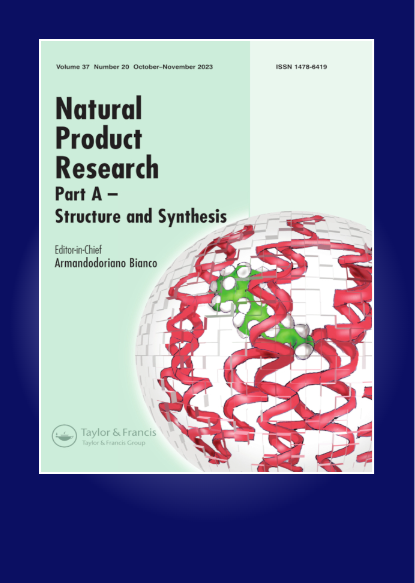Three new acridone alkaloids from Glycosmis lanceolata (Blume) D.Dietr. and their cytotoxic effects on tumour cell lines
IF 1.6
3区 化学
Q3 CHEMISTRY, APPLIED
引用次数: 0
Abstract
We separated and structurally elucidated three new acridone alkaloids (glycomontamine A (1), B (2), and C (3)), together with three known compounds (glycofoline, kokusaginine and dictamnine) from the acetone extract of Glycosmis lanceolata (Blume) D.Dietr. branches collected in Thailand. The compounds were assayed for cell viability using human lung adenocarcinoma cell line A549, breast adenocarcinoma cell line T47D, cervix epithelioid carcinoma cell line Hela, acute lymphoid leukaemia B cell line NALM-6, and human dermal fibroblasts. The viability of Hela cells treated with compound 1 (IC50 17.6 μM) and T47D cells treated with compound 2 (IC50 17.4 μM) decreased dose-dependently. Both compounds also showed cytotoxicity against NALM-6 cells (IC50 16.5 and 9.3 μM). Additionally, compound 1 decreased the mitochondrial membrane potential of Hela cells, whereas compound 2 did not change the mitochondrial membrane potential in T47D cells.
来自 Glycosmis lanceolata (Blume) D.Dietr. 的三种新的吖啶酮生物碱及其对肿瘤细胞系的细胞毒性作用。
我们从泰国采集的 Glycosmis lanceolata (Blume) D.Dietr. 树枝的丙酮提取物中分离并阐明了三种新的吖啶酮生物碱(glycomontamine A (1)、B (2)和 C (3))以及三种已知化合物(glycofoline、kokusaginine 和 dictamnine)。用人肺腺癌细胞株 A549、乳腺癌细胞株 T47D、宫颈上皮样癌细胞株 Hela、急性淋巴性白血病 B 细胞株 NALM-6 和人真皮成纤维细胞对这些化合物进行了细胞活力检测。用化合物 1 处理过的 Hela 细胞(IC50 值为 17.6 μM)和用化合物 2 处理过的 T47D 细胞(IC50 值为 17.4 μM)的存活率呈剂量依赖性下降。这两种化合物对 NALM-6 细胞也有细胞毒性(IC50 分别为 16.5 和 9.3 μM)。此外,化合物 1 会降低 Hela 细胞的线粒体膜电位,而化合物 2 则不会改变 T47D 细胞的线粒体膜电位。
本文章由计算机程序翻译,如有差异,请以英文原文为准。
求助全文
约1分钟内获得全文
求助全文
来源期刊

Natural Product Research
化学-医药化学
CiteScore
5.10
自引率
9.10%
发文量
605
审稿时长
2.1 months
期刊介绍:
The aim of Natural Product Research is to publish important contributions in the field of natural product chemistry. The journal covers all aspects of research in the chemistry and biochemistry of naturally occurring compounds.
The communications include coverage of work on natural substances of land and sea and of plants, microbes and animals. Discussions of structure elucidation, synthesis and experimental biosynthesis of natural products as well as developments of methods in these areas are welcomed in the journal. Finally, research papers in fields on the chemistry-biology boundary, eg. fermentation chemistry, plant tissue culture investigations etc., are accepted into the journal.
Natural Product Research issues will be subtitled either ""Part A - Synthesis and Structure"" or ""Part B - Bioactive Natural Products"". for details on this , see the forthcoming articles section.
All manuscript submissions are subject to initial appraisal by the Editor, and, if found suitable for further consideration, to peer review by independent, anonymous expert referees. All peer review is single blind and submission is online via ScholarOne Manuscripts.
 求助内容:
求助内容: 应助结果提醒方式:
应助结果提醒方式:


